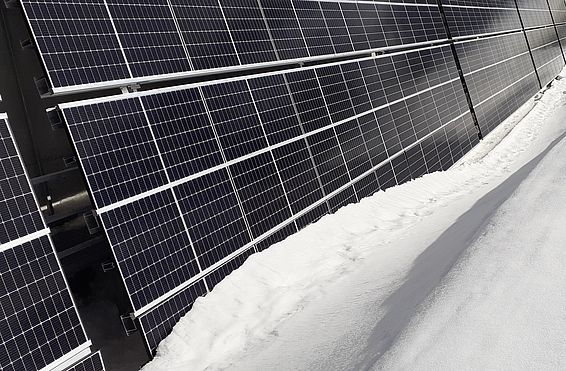This week, the photovoltaic sector will gather in Munich for Intersolar Europe, the world's leading exhibition for the solar industry. Solar plants in the Alps have the potential to deliver high output. The SLF analyses the threat they face from alpine hazards and helps to protect solar facilities.
Photovoltaic systems at high altitudes on mountainsides could be a successful model thanks to the high light intensity, sloped surfaces and a light efficiency exceeding that of the lowlands. Studies show that these facilities are ideally suited to plugging the power supply gap in the winter season. There are already some facilities in the Alps, for example Europe's highest solar power plant at almost 3,000 metres on the Pitztal Glacier in Austria. Furthermore, the snow reflects the sunlight in winter, generating additional power yields.
However, this snow also poses a hazard to the facilities. Developers often underestimated this problem in the initial projects in mountainous regions, but they are now aware of the issue and are drawing on the SLF's expertise, explains Stefan Margreth, head of the SLF's Avalanche Protection Measures research group. He adds: "Three factors threaten power plants in exposed locations: increased wind loads, snow pressure and avalanches."
Together with his team, Margreth analyses the hazards using simulation models such as RAMMS (Rapid Mass Movement Simulation) and identifies potential forces that could affect the facility. Researchers need to visit the site as this is the only way they can identify details such as depressions where substantial snowdrifts occur, or differences in the roughness of the terrain. "Every metre counts," says Margreth. He identifies avalanche starting zones, examines the snow depths over recent years and calculates snow pressure forces. The SLF uses drones to create snow depth maps for the project perimeter. The results vary considerably. "Sometimes there are no hazards, while sometimes just a few per cent of the original area remains as a safe zone," explains the engineer.
Margreth and his team not only analyse the hazards – they also offer potential solutions. "To avoid avalanches, it helps not to plan on or under areas with gradients steeper than 30 degrees," recommends the scientist. If the gradient is less than 30 degrees, avalanches are unlikely to occur.
However, snow pressure also occurs on flatter terrain up to a gradient of around 20 degrees when the snowpack slowly slides downhill. The effect is similar to a slow-moving slab avalanche. "This increases the forces on the substructure, which is often only designed for wind, not snow pressure." Additional forces act on the supports due to the snow. One solution is to strengthen supports and foundations.
It is also important to ensure the right distance between the ground and the photovoltaic modules. "If the distance chosen is too small, the wind load is reduced but the module can become snowed in and subject to snow pressure," explains Margreth.
Quotes as audio files for download (German only)
Contact
Links
-
Guideline Consideration of avalanche and snow pressure hazards for cableways (German only)
-
Instruction sheet on sliding snow (German only)
-
Technical guideline Defense structures in avalanche starting zones
Copyright
WSL and SLF provide image and sound material free of charge for use in the context of press contributions in connection with this media release. The transfer of this material to image, sound and/or video databases and the sale of the material by third parties are not permitted.
